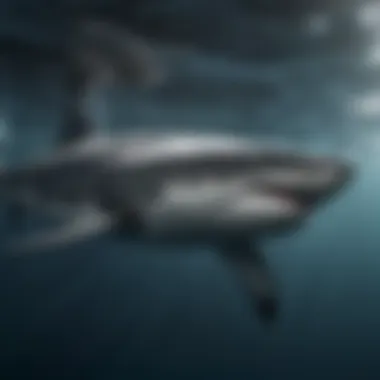Unraveling the Enigmatic World of Sharks: A Dive into Their Diverse Species


Animal Species Profile
Sharks, with their sleek bodies and rows of sharp teeth, are fearsome yet fascinating creatures that roam the depths of the oceans. From the iconic Great White to the rare Goblin shark, each species brings unique characteristics and adaptations that make them efficient predators in their marine environment. The physical appearance varies greatly between species, with some showcasing gray hues while others have patterned skins. Despite these differences, sharks are unmistakable by their streamlined bodies and cartilaginous skeletons that allow for swift and agile movement in the water.
Known for their global distribution, sharks inhabit diverse habitats ranging from coastal waters to deep oceanic trenches. They can be found in tropical seas, polar regions, and everywhere in between, showcasing impressive adaptability to various environmental conditions. Some species, like the Great White, are known to frequent specific areas, while others, such as the Hammerhead shark, undertake long migrations spanning thousands of kilometers.
The behavior of sharks is equally intriguing, with each species exhibiting distinct social interactions and hunting strategies. While some sharks are solitary creatures, others form schools or exhibit pack-like behavior when hunting. Their communication, often through body postures and chemical cues, plays a crucial role in mate selection and territorial defense. Additionally, sharks display a range of behaviors from cautious investigation to swift strikes, showcasing their prowess as apex predators in the oceanic food chain.
Conservation & Wildlife Efforts
Despite their role as apex predators, many shark species face threats to their survival due to human activities such as overfishing and habitat destruction. The declining population of sharks has raised concerns about the stability of marine ecosystems, prompting conservation efforts worldwide. Conservation organizations focus on raising awareness about the importance of sharks in the oceanic ecosystem and advocating for sustainable fishing practices.
Over the years, conservation initiatives have led to significant successes in protecting certain shark species from extinction. For instance, the establishment of marine protected areas and the implementation of fishing quotas have contributed to the recovery of populations like the Whale shark and the Nurse shark. Continued research and monitoring are essential in developing effective conservation strategies to ensure the long-term survival of these majestic predators.
Animal Behavior & Psychology
The behavior and psychology of sharks offer valuable insights into their biological adaptations and survival strategies in the marine environment. Communication among sharks involves a combination of visual, olfactory, and tactile cues that convey information about dominance, mating readiness, and potential threats. Shark reproductive behavior varies widely among species, with some engaging in elaborate courtship rituals while others pursue a more solitary approach.
In terms of cognitive abilities, sharks exhibit remarkable problem-solving skills when hunting for prey and navigating complex environments. Their sensory organs, including electroreceptors and keen senses of smell and vision, play a crucial role in detecting prey from afar and avoiding potential predators. Studies have shown that sharks possess impressive memory and learning capabilities, allowing them to adapt to changing environmental conditions and social dynamics.
Unique Facts & Trivia


Sharks, often viewed as intimidating predators, harbor a multitude of intriguing facts and behaviors that surprise and captivate enthusiasts. Did you know that the Bonnethead shark is the only shark species known to be omnivorous, feeding on both plants and small marine animals? This unexpected dietary choice sets it apart from its carnivorous counterparts and underscores the remarkable adaptability of sharks.
On the behavioral front, some sharks display quirky tendencies such as breaching, where they launch themselves out of the water in pursuit of airborne prey. This jaw-dropping spectacle is not only a remarkable sight but also showcases the agility and power that sharks possess. Moreover, certain species like the Lemon shark exhibit remarkable homing instincts, returning to the same breeding grounds year after year with impressive precision.
Pet Care & Tips
While owning a shark may seem like a daring choice, some species are suitable for responsible pet ownership given the right conditions and care. When selecting a pet shark, it's essential to consider the size of the species, its dietary requirements, and the necessary habitat setup. Sharks like the Bamboo shark are popular choices for home aquariums, requiring large tanks with ample swimming space and hiding spots.
Basic care for pet sharks includes maintaining water quality, feeding a well-rounded diet, and providing mental stimulation through environmental enrichment. Regular health check-ups are essential to monitor the wellbeing of your pet shark and address any potential issues promptly. Training techniques can also be employed to acclimate the shark to human interaction and facilitate handling for veterinary procedures, emphasizing positive reinforcement and respect for the animal's natural behaviors.
Introduction
Embark on a riveting journey into the enthralling realm of sharks, creatures that reign as masters of the vast and mysterious oceans. These apex predators have intrigued and captivated humankind for centuries, with their formidable presence and fascinating behaviors. As we delve into the depths of this article, we will uncover the mesmerizing world of sharks, shedding light on the diverse array of species that inhabit our seas.
Sharks: Masters of the Ocean
Evolutionary History
The evolutionary history of sharks is a captivating narrative that spans millions of years, showcasing their incredible ability to adapt and thrive in various marine environments. From ancient ancestors to present-day predators, sharks have evolved unique characteristics and traits that distinguish them from other sea creatures. Their evolution is a testament to nature's magnificent creations, highlighting the resilience and survival instincts that have allowed sharks to dominate the oceans.
Importance in Marine Ecosystems


Sharks play a crucial role in maintaining the delicate balance of marine ecosystems, acting as key predators that regulate the populations of prey species. Their presence helps control the food chain, preventing certain species from overpopulating and destabilizing the underwater environment. Furthermore, sharks contribute to biodiversity and resilience within ecosystems, showcasing their importance beyond being mere apex predators. Understanding the significant role that sharks play in marine ecology is essential for conserving these majestic creatures and preserving the richness of our oceans.
Types of Sharks
In this comprehensive exploration of the fascinating world of sharks, understanding the various types plays a crucial role. The diversity among different shark species provides valuable insights into their unique adaptations, behaviors, and ecological significance within marine ecosystems. By delving into the distinct characteristics and roles of each shark type, we can gain a deeper appreciation for the crucial role sharks play in maintaining the delicate balance of our oceans. Exploring the types of sharks is like unraveling a complex puzzle, each piece contributing to the greater picture of marine biodiversity and conservation.
Great White Shark
Physical Characteristics
Exploring the iconic Great White Shark, its physical characteristics stand out as a pinnacle of evolutionary success. The species' streamlined body, powerful jaws lined with serrated teeth, and keen senses make it a top predator in the ocean. The Great White's ability to grow to considerable sizes, reaching lengths of up to 20 feet, showcases its prowess in the marine food chain. Its distinctive white underside acts as camouflage from potential prey below, aiding in its hunting strategies and survival. Despite controversies surrounding its portrayal in popular culture, the Great White Shark's physical characteristics remain a subject of awe and scientific study.
Hunting Behavior
The hunting behavior of the Great White Shark epitomizes efficient predatory tactics honed through years of evolution. Utilizing ambush techniques, burst swimming speeds, and acute senses, the Great White excels in targeting marine mammals such as seals and sea lions. Its ability to breach the surface in spectacular displays of hunting prowess has captivated researchers and enthusiasts alike. Despite its ferocious reputation, the Great White's role in regulating marine populations ensures a healthy ecosystem balance. Understanding its hunting behavior unveils the intricate dynamics of predator-prey relationships prevalent in the ocean.
Conservation Status
Grappling with conservation concerns, the Great White Shark faces threats from overfishing, habitat degradation, and climate change. As a keystone species in marine ecosystems, its decline could have cascading effects on ocean health. Initiatives focusing on studying and protecting Great Whites have had varying levels of success, showcasing the challenges in safeguarding such iconic creatures. By highlighting the conservation status of the Great White Shark, awareness can be raised about the importance of preserving these apex predators for future generations.
Hammerhead Shark


Distinctive Hammer-shaped Head
Central to the Hammerhead Shark's allure is its unique hammer-shaped head, known as the cephalofoil. This distinctive feature plays a crucial role in enhancing the shark's sensory perception and maneuverability. The extended width of the head allows for better vision and detection of prey, giving the Hammerhead a significant advantage during hunts. Despite evolutionary advantages, the hammer-like structure also poses challenges in terms of hydrodynamics, requiring the shark to adapt its swimming patterns for optimal efficiency.
Social Behavior
Contrary to popular belief, Hammerhead Sharks exhibit complex social behaviors within their schools. These sharks engage in intricate communication methods, hierarchy formations, and cooperative hunting strategies. The social dynamics among Hammerheads offer valuable insights into the intelligence and adaptability of these marine predators. By studying their social behavior, researchers can unravel the intricate web of interactions that contribute to the survival and success of Hammerhead Shark populations.
Feeding Habits
The feeding habits of Hammerhead Sharks are as diverse as their unique head shapes. While some species prefer a diet of smaller fish and crustaceans, others display more opportunistic feeding behaviors, including scavenging and occasional cannibalism. The varied diet of Hammerhead Sharks reflects their adaptability to different marine environments and prey availability. Understanding their feeding habits provides crucial information on the role these sharks play in maintaining the biodiversity and health of ocean ecosystems.
Conclusion
In delving deep into the fascinating world of sharks, it becomes evident that these creatures play a crucial role in maintaining the delicate balance of marine ecosystems. Sharks are not merely fearsome predators but are integral to the overall health of our oceans. Understanding the importance of conserving shark species is paramount to preserving the biodiversity and sustainability of our seas. This article sheds light on the challenges faced in shark conservation, the critical role sharks play in marine ecology, and the significance of educational initiatives in promoting conservation efforts.
Preserving Shark Species
Challenges to Conservation:
Exploring the challenges of conserving shark species unveils a complex landscape where human activities such as overfishing, bycatch, and habitat destruction pose significant threats to their survival. The indiscriminate nature of fishing practices often results in high rates of shark mortality, pushing many species to the brink of extinction. Addressing these challenges requires concerted efforts in implementing sustainable fishing practices, enforcing regulations, and raising awareness about the importance of shark conservation.
Critical Role in Marine Ecology:
The critical role that sharks play in marine ecology cannot be understated. As apex predators, sharks regulate the balance of the marine food web by controlling the population of prey species. Their presence ensures the health of coral reefs and seagrass beds by preventing overgrazing of important habitats. Moreover, by scavenging on sick and weak individuals, sharks help maintain the overall fitness of marine populations, contributing to ecosystem stability and resilience.
Educational Initiatives:
Educational initiatives form the cornerstone of effective shark conservation efforts. By educating communities, fishermen, policymakers, and the general public about the significance of sharks in marine ecosystems, these initiatives foster a culture of conservation and sustainable practices. Through interactive programs, outreach events, and campaigns, stakeholders are engaged in conservation activities that aim to protect sharks and their habitats for future generations. Empowering individuals with knowledge is key to ensuring long-term success in preserving shark species and promoting marine biodiversity.







